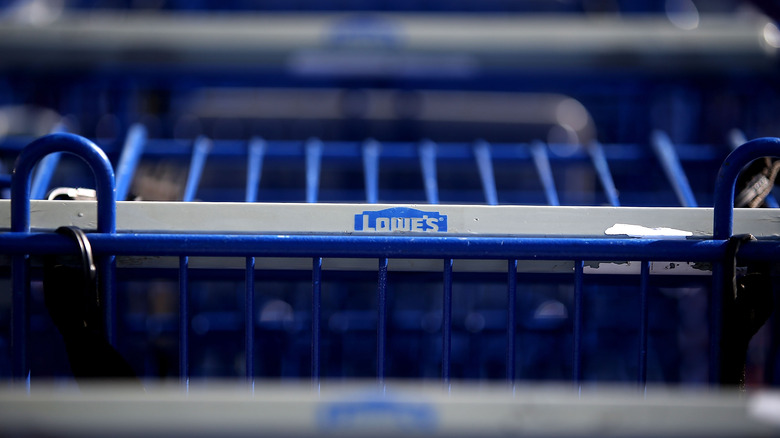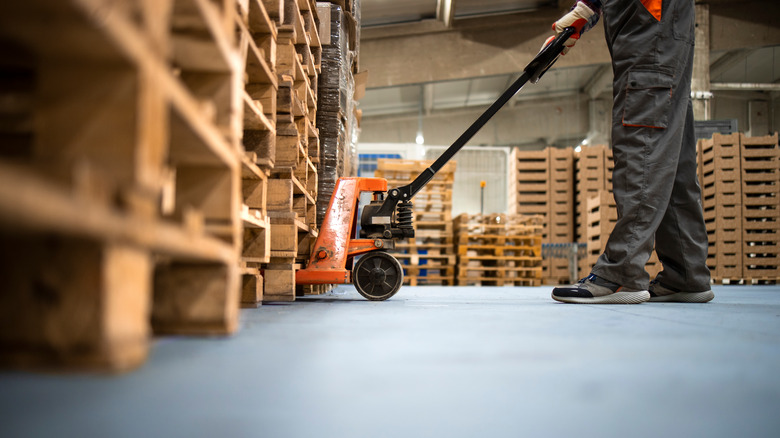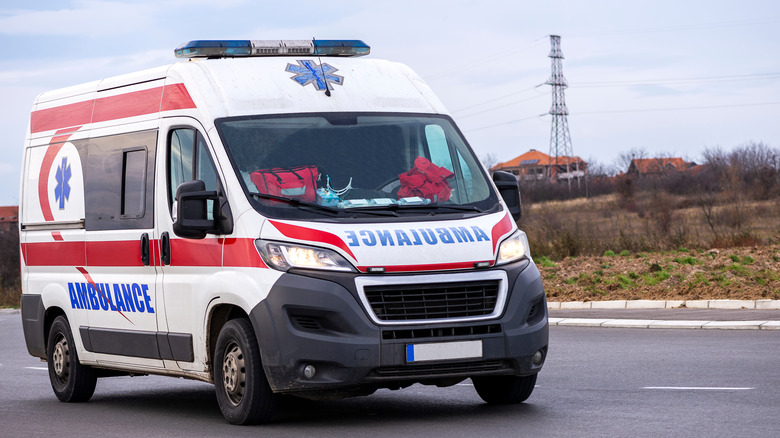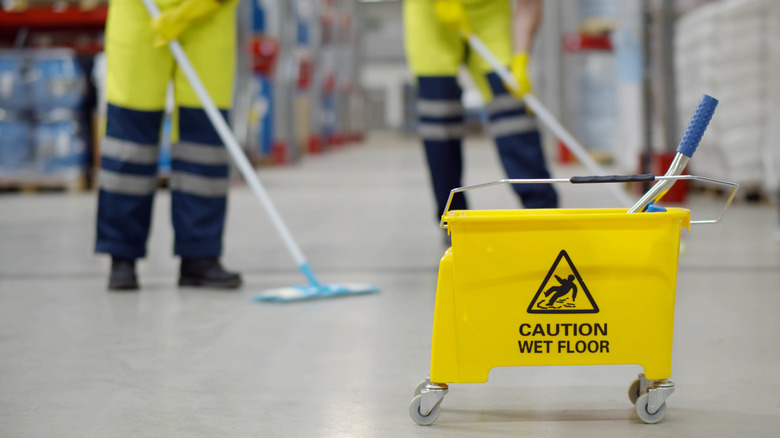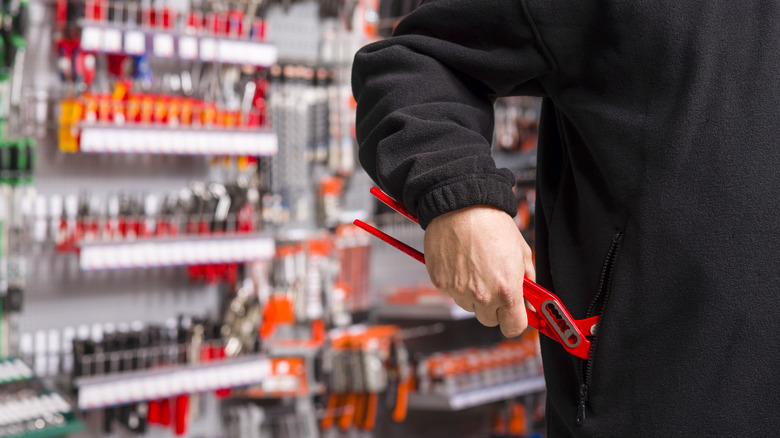What Do The Secret Intercom Codes Mean At Lowes?
As you're browsing the aisles of your local Lowe's hardware store, you may notice some vague announcements come over the intercom. Numbers, colors, and even people's names may be thrown around. You might wonder, "did I miss something? Is there a made-up language for rewards club members?" These intercom codes aren't announcements about secret sales; they're actually important communication tools for Lowe's staff and emergency responders.
The importance of these codes may come as no surprise to those familiar with hospital protocols. In the medical system, code blue can indicate cardiac arrest, and code red could indicate fire at the hospital (via Medical News Today). But what does it mean when you hear "code 50" or "code green" in a Lowe's? What kind of emergencies might arise in a friendly neighborhood hardware store? Here's what Lowe's most common intercom codes mean and what you should do next time you hear them.
Codes 3, 50, and 75
Anytime you go to a Lowe's store, you'll probably hear someone announce a code 3, code 50, or code 75 over the intercom. All of these codes refer to employee directions, so there's no need for customers to be concerned. According to Appliance Analysts, Lowe's has a good reputation for its wide selection of appliances, affordable delivery, and great customer service. Intercom codes are necessary to keep these operations running as smoothly as possible. Codes 3, 50, and 75 are "all hands on deck" codes, so unless an employee is busy with a customer, they'll need to report to that area of the store.
A code 3 simply means that a customer needs assistance or the store needs more staff in a particular department. Code 3's are usually followed up with a specific direction, such as "code 3 in plumbing" or "code 3 in lighting." Code 50 and code 75 also mean that employee assistance is needed, but these codes are more specific. A "code 50" announcement indicates that someone needs help in the loading bay or taking an item out to their vehicle, like heavy, clunky appliances. Code 75 most often refers to the cart corrals in the parking lot. If the cart supply runs low in-store or corrals start to overflow, code 75 calls employees to gather up the carts from the parking lot.
Code 99
You don't need to panic if you hear a code 99, but this is typically an emergency code. A code 99 is somewhat vague, but it could indicate a worker injury, customer health problem, or other situation that requires everyone to stay calm and collected. Hardware stores can be precarious places to work (or even shop) due to equipment and heavy merchandise. Some of the most common workplace injuries include trips, falls, crashes, strains, and injuries from heavy lifting (via Psychreg).
If you hear a code 99 announcement, emergency services like police and EMS are probably on their way to the Lowe's store. However, this code doesn't always mean that someone is hurt; code 99 could also refer to a potentially dangerous situation that doesn't yet constitute an emergency. These non-emergency situations could include chemical spills, power outages, or shelving collapses. After a code 99 announcement, customers may be asked to stay put until they receive further instructions. If necessary, staff will ask customers to leave the store, but most likely, the situation will be resolved, in which case you'll hear a "code 4" announcement come over the intercom. Code 4 means that staff and/or authorities have the situation under control, and customers can return to their shopping.
Code yellow
If you hear a "code yellow" in your aisle, you may want to watch your step. Code yellow indicates that someone, typically a child but sometimes an older adult, has had a bathroom accident on the floor. Most often, this will just be a puddle of urine, which is relatively safe and easy to clean up. Code yellow is used to discreetly call employees to the accident and ensure that they can clean the mess as quickly as possible. In most situations, a code yellow is of minor concern to customers, although it can be an inconvenience if it's in your aisle.
However, if other bodily fluids are present, a code yellow could turn into a more serious situation. For safety reasons, most retail stores, including Lowe's, will not require their employees to clean up biohazardous bodily fluids. According to specialists at Aftermath, human blood, vomit, feces, and sexual secretions are potential biohazards that must be contained and removed by a professional crew. Failure to properly contain and clean these fluids could expose employees and customers to diseases.
Code green and code Adam
Code "green" and code "Adam" are two more serious situations. If you hear either of these codes announced over the intercom, it's crucial to pause your shopping and observe your surroundings. A code green announcement could indicate a hostage situation with an employee or customer. Code Adam is named after Adam Walsh, a child who was abducted from a Sears store in 1981(via The New York Times). If employees hear a code Adam (or sometimes code Sarah), they are required to drop what they're doing, monitor the exits, and look for the lost child. Kids frequently get distracted by merchandise and wander away from their parents, but if employees can't find the missing child within ten minutes, they will call the police.
You may be wondering, "if there's an emergency, why does Lowe's use a code? Why not warn all of the store customers?" In a code green or code Adam situation, announcing the potential threat out loud could make things worse. A code Adam kidnapper may try to rush the missing child out of the store quickly, or a code green perpetrator could become angry with the hostage. Codes are the best way to alert all store staff and employees without causing panic throughout the store. If you hear a "code 4" after code green or code Adam, this means that everything is under control, and you can return to your shopping.
Top secret intercom codes
There are dozens of possible codes that you could hear in stores like Lowe's and Walmart, including more numbers, colors, and secret phrases (via The U.S. Sun). If you hear a code that isn't on this list, don't worry; some of Lowe's intercom codes are not shared with the public. In addition to remaining a secret, special intercom codes may vary by region and Lowe's store location. These codes are kept top secret in order to make them more effective and keep everyone safe in bad situations. For example, Lowe's intercom code for shoplifting is not shared publicly because announcing this code could alert the suspected shoplifter and escalate the situation.
It's important to be aware of your surroundings and pay attention when you hear an announcement over the intercom. Most of the time, intercom codes are simple directions for employees and not something that should raise concerns for customers. In a true, pressing emergency, Lowe's staff will always do their best to ensure that customers are safe. Trust that if you need to evacuate the store, protect yourself, or seek shelter, employees will let you know via the intercom system.
